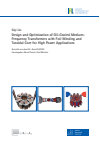Design and Optimization of Oil-Cooled Medium-Frequency Transformers with Foil Winding and Toroidal Core for High Power Applications
Zusammenfassung
Due to the continuous development of semiconductor technology, the operating frequency of medium-voltage DC systems has been increasing, resulting in a reduction in the size and weight of medium-frequency transformers(MFTs). However, the increase in frequency and the decrease in size have brought many challenges to the design of MFTs. Finding a trade-off between insulation, cooling system, losses, and electrical parameters has become the key to achieving high power density and high efficiency. In this thesis, a structure of medium-frequency transformer with toroidal core and foil windings for high-current, high-power applications is presented, for which analytical models from the literature have been adapted in order to achieve an optimal design. The final results are experimentally validated.
Schlagworte
- Kapitel Ausklappen | EinklappenSeiten
- I–XX Titelei/Inhaltsverzeichnis I–XX
- 1–12 1 Introduction 1–12
- 1.1 Background and Motivation
- 1.2 Fundamentals of Two-Winding Transformers
- 1.3 State of the Art
- 1.4 Challenges
- 1.5 Outline of the Thesis
- 13–20 2 Thermal Behavior Model, Insulation and Cooling Concepts 13–20
- 2.1 Thermal Behavior Model
- 2.2 Insulation
- 2.3 Cooling Concepts
- 2.4 Conclusion
- 21–52 3 Windings 21–52
- 3.1 Winding Losses
- 3.2 Leakage Inductance
- 3.3 Magnetizing Inductance
- 3.4 Parasitic Capacitance
- 3.5 Conclusion
- 53–74 4 Magnetic Cores and Core Losses 53–74
- 4.1 Magnetic Cores
- 4.2 Core Losses
- 4.3 Conclusion
- 75–102 5 Optimized Design and FEM Simulation Validation 75–102
- 5.1 Flow Chart
- 5.2 Topology of the DC-DC Converter
- 5.3 Design Procedure
- 5.4 Candidate Selection and Optimization Results
- 5.5 FEM Simulation Validation
- 5.6 Conclusion
- 103–116 6 Prototype and Experimental Validation 103–116
- 6.1 Prototype
- 6.2 Experimental Validation
- 6.3 Conclusion
- 117–120 7 Summary, Conclusions and Future work 117–120
- 121–124 A Appendix 121–124
- 125–138 Bibliography 125–138
- 139–141 Wissenschaftlicher Werdegang 139–141


